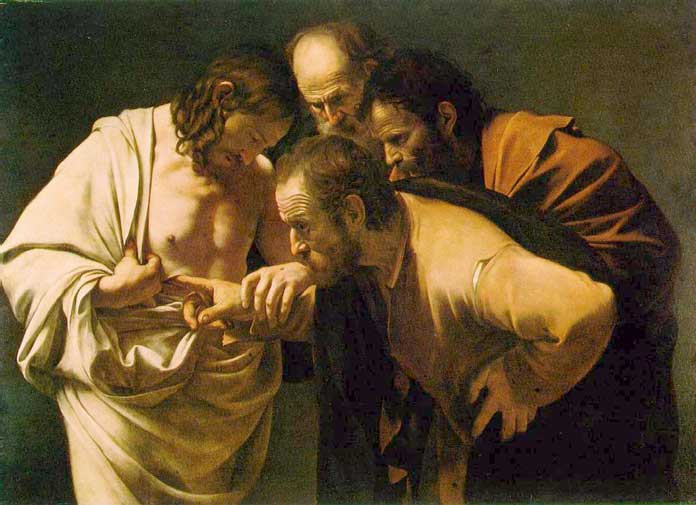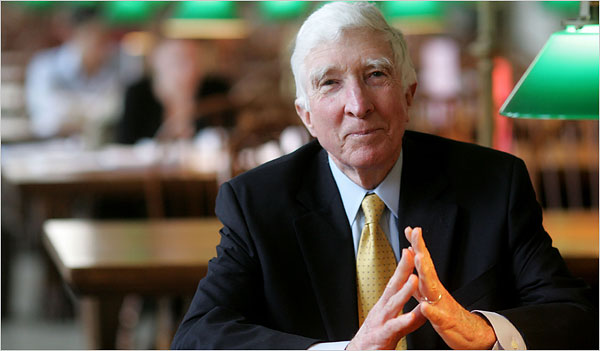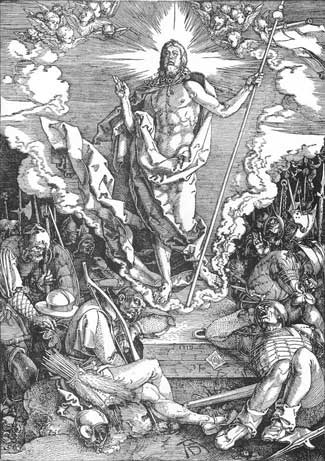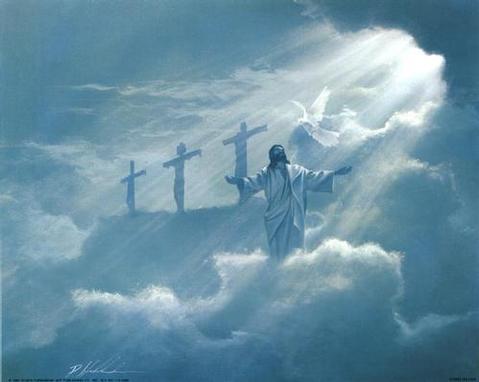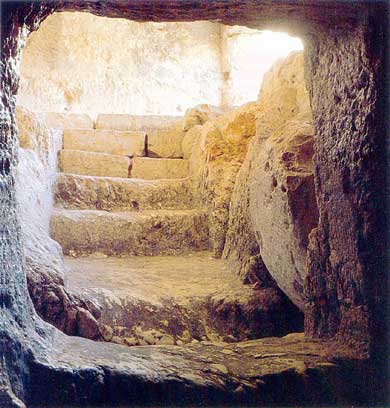Caravaggio, The Incredulity of St. Thomas, c. 1601-1602Of the untold number of poems inspired by the story of Jesus’ resurrection, none have engendered as much speculation, interpretation and consideration as to its greater meaning than John Updike’s ‘Seven Stanzas at Easter.’ In this year’s marking of Easter in the pages of TheBluegrassSpecial.com, we offer the Updike poem; the story of its discovery in 1960 when the young poet entered it in a Massachusetts church’s Religious Arts Festival and won a $100 prize for “Best of Show”; and the view from the pulpit on the import of Updike’s call for Easter not to be ‘trivialized, reduced to a happy ending or a pious parable,’ as one of these distinguished clerics puts it. Happy Easter!
Seven Stanzas for Easter
By John Updike
(from Telephone Poles and Other Poems, 1963)
Make no mistake: if He rose at all
It was as His body;
If the cell's dissolution did not reverse, the molecules
reknit, the amino acids rekindle,
the Church will fall.It was not as the flowers,
Each soft Spring recurrent;
It was not as His Spirit in the mouths and fuddled
eyes of the eleven apostles;
It was as His flesh; ours.The same hinged thumbs and toes
The same valved heart
That-pierced-died, withered, paused, and then
Regathered out of enduring Might
New strength to enclose.Let us not mock God with metaphor,
Analogy, sidestepping, transcendence;
Making of the event a parable, a sign painted in the
Faded credulity of earlier ages:
Let us walk through the door.The stone is rolled back, not papier-maché,
Not a stone in a story,
But the vast rock of materiality that in the slow
grinding of time will eclipse for each of us
The wide light of day.And if we have an angel at the tomb,
Make it a real angel,
Weighty with Max Planck's quanta, vivid with hair,
Opaque in the dawn light, robed in real linen
Spun on a definite loom.Let us not seek to make it less monstrous,
For our own convenience, our own sense of beauty,
Lest, awakened in one unthinkable hour, we are
Embarrassed by the miracle,
And crushed by remonstrance.
***
The Story Behind Seven Stanzas
By Kathleen Kastilahn
Norman D. Kretzmann remembers John Updike as a young Harvard graduate who sought out Clifton Lutheran Church in Marblehead, Mass., because it "nurtured the roots of faith he had grown up with in Pennsylvania."
Kretzmann, pastor of Marblehead at the time, proudly recalls that Updike was among the 96 adults who entered the congregation's Religious Arts Festival in 1960--and that his poem, Seven Stanzas at Easter, won $100 for "Best of Show."
"People in the parishes I served became quite accustomed to my quoting his poem in my Easter sermons at least every few years," says Kretzmann, who lives in a Minneapolis retirement center and regularly contributes to the Metro Lutheran newspaper.
Kretzmann closely follows Updike's work, which includes more than 50 novels and books of poems. In a Metro Lutheran review of John Updike and Religion (Eerdmans Publishing Co., 2000) he wrote: "I was John Updike's pastor during the time which the writer later described as his 'angst-besmogged period.' Who was the rabbi and who was the disciple of our years together is hard to say."
The pastor still has Updike's 41-year-old typed copy of Seven Stanzas--"marked up with all sorts of irrelevant notes by me, instructions to me for homiletical purposes or for various secretaries," he said. And Kretzmann has one more fond memory from the festival: Updike gave the $100 prize back to the congregation.
***
The Resurrection of Christ by Albrecht Durer, 1510‘Without the Resurrection, Jesus Was Just Another Wise Teacher…’
PASTOR'S PONDERINGS, MARCH 2011
Rev. Dr. Brad Donahue
http://christiantemple.net/Documents/March%202011%20Temple%20Talk.pdfThe celebration of Easter is as late as can be on the calendar so we have a better chance this year of warm weather for Easter Sunday. Likewise Lent starts later so we have spent more time in the church season of Epiphany then we usually do.
Both occurrences can be a little unsettling for us, we are not use to such lateness in the church calendar. We usually move through the seasons fairly quickly. But not this year, this year Easter will take its own sweet time coming.
Church historian tells us the in the early church Easter not the celebration of Christ's birth was the most important holiday. The early church was slow in recognizing the celebration of Christmas. There is some theological soundness in this. I love Christmas but what is most significant to the faith is that God worked a marvelous miracle on Easter morning.
Without the resurrection, Jesus was just another wise teacher, who taught some very important things.
What sets him apart from all others is the proclamation of the angel, "He is not here. He is risen."
American author John Updike in his poem, "Seven Stanzas at Easter" writes:
Make no mistake: if He rose at all
It was as His body;
If the cell's dissolution did not reverse, the molecules
reknit, the amino acids rekindle,
the Church will fall.Maybe Updike has a point, maybe we don't take the power of the resurrection seriously enough.
It was the event that drove the early church and empowered them to proclaim the good news.
As we enter Lent 2011 perhaps this would be a good time to reflect on what the Resurrection means for us.
1 Cor 15:14-17
…and if Christ has not been raised, then our proclamation has been in vain and your faith has been in vain. We are even found to be misrepresenting God, because we testified of God that he raised Christ-whom he did not raise if it is true that the dead are not raised. For if the dead are not raised, then Christ has not been raised. If Christ has not been raised, your faith is futile and you are still in your sins.Grace and Peace,
Dr. BradVOLUME 1, ISSUE 3
TEMPLE TALKPosted at the website of Christian Temple Disciples of Christ (PDF File)
***
‘A Resuscitation View of The Resurrection’
Make no mistake: if He rose at all
It was as His body;
If the cell's dissolution did not reverse, the molecules
reknit, the amino acids rekindle,
the Church will fall.It was not as the flowers,
Each soft Spring recurrent;
It was not as His Spirit in the mouths and fuddled
eyes of the eleven apostles;
It was as His flesh; ours.These are two of John Updike's seven “stanzas at Easter,” famous for their rigorously material way of representing the resurrection of Jesus Christ. Of course the poem is just that--a poem, not a theological treatise in disguise. That being conceded, it is nevertheless interesting to see what it aims at theologically. Clearly, the poem voices a resuscitation view of the resurrection that may strike us as crude, highly disturbing and even offensive. Where in the New Testament do we find the resurrection depicted in such a vividly realistic way as in the first of these stanzas? Clearly, the New Testament reports are consistent in not portraying the resurrection as a kind of reversal of natural biochemical processes, but as a transformation into a new kind of existence, characterized by a physicality that displays both continuity and discontinuity with our present physicality. At the same time, however, we intuitively feel that Updike has a point. If we are to think about the resurrection with integrity, we cannot escape thinking about it in its concrete materiality. For clearly, sheer analogy and parable can hardly bear the weight of real hope which springs from the resurrection stories.
But can we still subscribe to such a "realist" view of the resurrection, given the host of old and new objections that have been and are being put forward against it? Or to put this question in a more open way: can we speak with intellectual and theological integrity on the resurrection of Christ today, and if so how?
From “How to speak with intellectual and theological decency on the resurrection of Christ?: A comparison of Swinburne and Wright,” by Gijsbert van den Brink
Faculty of Theology, VU University Amsterdam, Netherlands
http://dare.ubvu.vu.nl/bitstream/1871/15837/2/sjt-resurrection.pdf
***
‘What Door Now Stands Open?’
excerpt from EASTER DAY SERMON 2004
by the Bishop of Meath and Kildare,
the Most Revd Dr. Richard Clarke
at St. Brigid's Cathedral, Kildare, Easter Day, 11 April 2004Revelation 3.8 "I have set before you an open door which no one can shut.”
The Gospels are of course certainly talking about the Resurrection as a real event, an event in human history. There is, as we know, a condescending and superior approach to the whole matter which suggests that the Gospel writers were speaking of a symbolic resurrection, that Jesus remained very much dead, and that what we call Easter was merely a realization on the part of the disciples that this man Jesus Christ was possibly on the right lines after all. His resurrection was in their heads and in their imagination, but nowhere else. This is, it seems to me, staggeringly patronizing--patronizing about the Gospel writers who would have known perfectly well how to make it clear if they were writing metaphor, patronizing about generation upon generation of great Christian thinkers and writers who were in fact not gullible idiots, patronizing about us who don't like to think of ourselves either as fools or as fantasists. It's actually patronizing about God as well. As the American writer and poet John Updike puts it so neatly, in one of his Seven Stanzas at Easter,
Let us not mock God with metaphor,
analogy, sidestepping transcendence;
making of the event a parable, a sign painted in the
faded credulity of earlier ages;
let us walk through the door.The question accordingly becomes a matter, not only of the objective reality of Resurrection, but also of the impact on the lives of disciples. disciples of the twenty-first century as of the first century--of how disciples walk through this door of which both the writer of the Book of Revelation and John Updike speak to us. The question becomes, "What effect does the resurrection of Jesus Christ have on our lives?" "What door now stands open?"
*The Resurrection means first that, as individuals, we must look at Christ in a different way. Mary Magdalene, who had loved and admired him before, now finds herself utterly transformed by him. She becomes different, because everything falls into place. All that he had said and had done were no longer the words and actions of a good man, even the best man there had ever been, it had all been given an eternal reality for her which could not be contradicted or ever destroyed. No matter how often we are told that it will not do to patronize Christ, and to treat him as an amiable carpenter with a good line in stories (who would however not have survived for very long in any real grown-up world), we still do it. The resurrection is the playing of the trump card which tells us that if we not treat him with the utmost seriousness and with total reverence, it is we who are the buffoons.
*It means also that we cannot look at others in the same way. Most of the resurrection stories are stories of Christ's friends meeting together--in a room, in a boat, on a beach, walking to a village. The Easter event is about sharing faith, being part of a community which celebrates the presence of Jesus Christ. We are pushed again and again in the Easter stories to realize that Christ is real and present with us in the Eucharist, the meal of the Church, as he shares food in a village room, as he asks for food on a shore, as he eats with his disciples in a room in Jerusalem. The risen Christ joins with his followers as they meet together. This is why it is so immensely foolish to imagine that we are somehow doing God a favor when we turn up in church for a service. Worship should never be seen as anything other than an immense privilege to be treated with the greatest humility and reverence, as the God who created us, who keeps us in being and who has smashed through the dreadfulness of death ahead of us, is ready to join us as companion and friend. Christian worship, Christian community and Christian fellowship become Easter gifts to be prized and revered, and for which we should be ever and profoundly thankful to God.
*It means that we can face ourselves in a new way. What are we as individuals without the resurrection? A moderately sophisticated organism which, simply because it has a thing called a "mind,” gets ideas far above its station, but which nevertheless ceases to exist after a few brief spins of a grubby little planet around the nearest, rather insignificant star. It is God in Christ, God in the risen Christ, who gives us a real dignity and a true purpose. This is not the bogus dignity we so readily give ourselves. This is the dignity of being a child of God, given a function and given a purpose to bring others into loving fellowship with him. I have no doubts that the value of our earthly life will be measured in the context of eternity, neither by how much we accumulated for ourselves, nor by how much others feared us or envied us, but by how much more Christian this world became, because we lived in it. And this conviction, if you think about it, only makes any sense in the light of Easter.
Easter is of course far, far more than a good reason for being a Christian. This is why we must never trivialize it, or reduce it to a happy ending or a pious parable. It is an open door to faith, to hope, to love, and thus to the fullness of eternal life.
"I have set before you an open door which no one can shut.”
Published at Diocesan News-Church of Ireland
The Resurrection by petersheep (Pedro Caram), an atheist who believes ‘religion is a great way to express art.’
Founder/Publisher/Editor: David McGee
Contributing Editors: Billy Altman, Laura Fissinger, Christopher Hill, Derk Richardson
Logo Design: John Mendelsohn (www.johnmendelsohn.com)
Website Design: Kieran McGee (www.kieranmcgee.com)
Staff Photographers: Audrey Harrod (Louisville, KY; www.flickr.com/audreyharrod), Alicia Zappier (New York)
E-mail: thebluegrassspecial@gmail.com
Mailing Address: David McGee, 201 W. 85 St.—5B, New York, NY 10024


